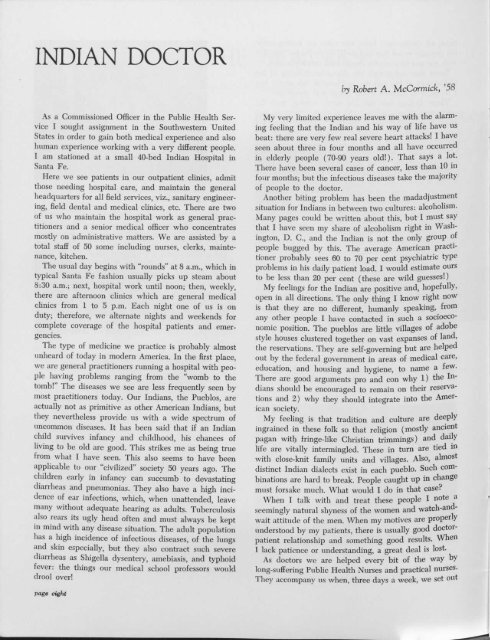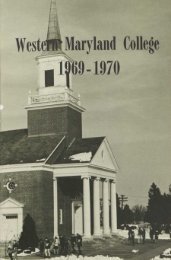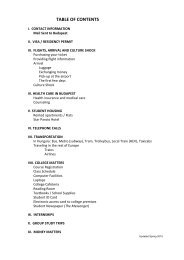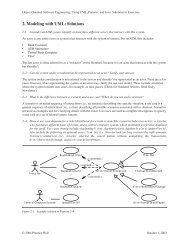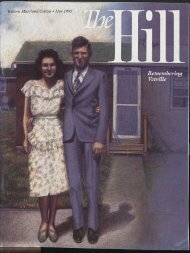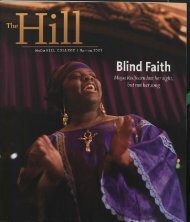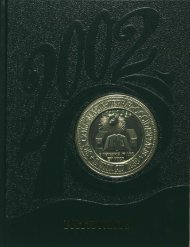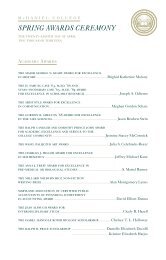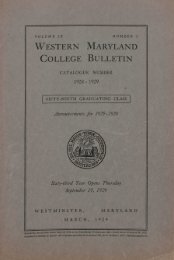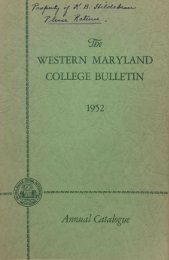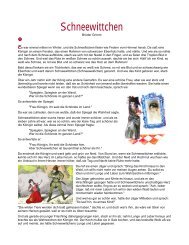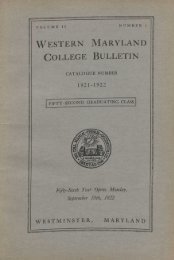You also want an ePaper? Increase the reach of your titles
YUMPU automatically turns print PDFs into web optimized ePapers that Google loves.
INDIAN DOCTORb)' Robert A. McCormick, '58As a Commissioned Officer in the Public Health ServiceI sought assignment in the Southwestern UnitedStates in order to gain both medical experience and alsohuman experience working with a very different people.I am stationed at a small 40-bed Indian Hospital inSanta Fe.Here we see patients in our outpatient clinics, admitthose needing hospital care, and maintain the generalheadquarters for all field services, viz., sanitary engineering,field dental and medical clinics, etc. There are twoof us who maintain the hospital work as general practitionersand a senior medical officer who concentratesmostly on administrative matters. We are assisted by atotal staff of 50 some including nurses, clerks, maintenance,kitchen.The usual day begins witb "rounds" at 8 a.m., which intypical Santa Fe fashion usually picks up steam about8:30 a.m.; next, hospital work until noon; then, weekly,there are afternoon clinics which are general medicalclinics from 1 to 5 p.m. Each night one of us is onduty; therefore, we alternate nights and weekends forcomplete coverage of the hospital patients and emergencies.The type of medicine we practice is probably almostunheard of today in modern America. In the first place,we are general practitioners running a hospital with peoplehaving problems ranging from the "womb to thetomb!" The diseases we see are less frequently seen bymost practitioners today. Our Indians, the Pueblos, areactually not as primitive as other American Indians, butthey nevertheless provide us with a wide spectrum ofuncommon diseases. It has been said that if an Indianchild survives infancy and childhood, his chances ofliving to be old are good. This strikes me as being truefrom what T have seen. This also seems to have beenapplicable to our "civilized" society 50 years ago. Thechildren early in infancy can succumb to devastatingdiarrheas and pneumonias. They also have a high incidenceof ear infections, which, when unattended, leavemany without adequate hearing as adults. Tuberculosisalso rears its ugly head often and must always be keptin mind with any disease situation. The adult populationhas a high incidence of infectious diseases, of the lungsand skin especially, but they also contract such severediarrheas as Shigella dysentery, amebiasis, and typhoidfever: the things our medical school professors woulddrool over!My very limited experience leaves me with the alarmingfeeling that the Indian and his way of life have usbeat: there are very few real severe heart attacks! I haveseen about three in four months and all have occurredin elderly people (70-90 years old!). That says a l~t.There have been several cases of cancer, less than 10 mfour months; but the infectious diseases take the majorityof people to the doctor.Another biting problem has been the madadjustmentsituation for Indians in between two cultures: aleo·bolism.Many pages could be written about this, but I must saythat I have seen my share of alcoholism right in Washington,D. c., and the Indian is not the only group ~fpeople bugged by this. The average American pracutionerprobably sees 60 to 70 per cent psychiatric typeproblems in his daily patient load. I would estimate oursto be less than 20 per cent (these are wild guessesl)My feelings for the Indian are positive and, hopefully,open in all directions. The only thing I know right nowis that they are no different, humanly speaking, fromany other people I have contacted in such a socioeconomicposition. The pueblos are little villages of adobestyle houses clustered together on vast expanses of land,the reservations. They are self-governing but are helpedout by the federal government in areas of medical care,education, and housing and hygiene, to name a few.There are good arguments pro and con why 1) the Indiansshould be encouraged to remain on their reservationsand 2) why they should integrate into the Americansociety.My feeling is that tradition and culture are deeplyingrained in these folk so that religion (mostly ancie.ntpagan with fringe-like Christian trimmings) and dal~ylife are vitally intermingled. These in turn are tied Inwith close-knit family units and villages. Also, almostdistinct Indian dialects exist in each pueblo. Such combinationsare hard to break. People caught up in changemust forsake much. What would I do in that case?When I talk with and treat these people I n~::d~seemingly natural shyness of the women a~d watch Iwait attitude of the men. when my motives are proper Yunderstood by my patients, there is usually good doctorpatientrelationship and something good results. When1 lack patience or understanding, a great deal is lost. bAs doctors we are helped every bit of the way ylong-suffering Public Health Nurses and practical nurses.They ,lccompany us when, three days a week, we set outpageeighf


